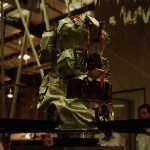ALEXIS / BLACKBEARD
Launched April 25, 1993, the $17 million Department of Energy-funded Array of Low-Energy X-ray Imaging Sensors [ALEXIS] satellite lasted well beyond its nominal one-year mission to demonstrate its telescope and radio-receiver technology for nonproliferation applications. The spin-stabilized satellite had a significant wobble caused by a damaged solar panel. Because of the initial damage to ALEXIS, the team could not contact the satellite for the first six weeks after launch, causing them to fear it was lost. The damage also left ALEXIS unable to provide precise information about its orientation as it was originally designed to do. The ALEXIS team had to find a new way to determine where each of the satellite's six X-ray telescopes points at any given moment -- essential for reconstructing an image of the sky.
BLACKBEARD is a Los Alamos National Laboratory Radio Frequency (RF) detection experiment that shares power and onboard computer/memory/data storage resources with the ALEXIS satellite payload. Blackbeard was able to begin operations almost as soon as the onboard batteries reached viable charge states, since the spacecraft wobble has no noticeable effect on the relatively non directional antennas used. Blackbeard demonstrated technology for studying a wide band of radio frequencies and capturing signals of interest amidst a noisy radio background, important for nonproliferation work. The Blackbeard radio experiment, however, has been superceded by Los Alamos' FORTÉ satellite.
The principal source of impulsive noise visible to satellite RF receivers is lightning. The fundamental nature of the RF emissions of lightning, after having passed through the ionosphere, must be understood in order to separate lightning signals from those of national security interest. In particular, a comprehensive understanding of the correlation between the optical flash and the VHF emissions from lightning must be established. In order to resolve the time correlation, the location of the optical lightning flash, as well as the time dependance of the light intensity requires comprehensive scientific measurement.
Observations made by the Blackbeard instrument on the ALEXIS satellite include digitized records of the electric field in a passband from about 25 to 100 MHz. These observations of transient radio impulses appeared to be quite unlike any previously reported. They appear as pairs of brief (a few microseconds) noise-like bursts, separated by a few tens of microseconds, and are dispersed in a way that implies sub-ionospheric origin. These Trans-Ionospheric Pulse Pairs (TIPPs) have not yet been associated with any known source, although thunderstorms were suspected.


Sources
- ALEXIS satellite marks fifth anniversary of launch LOS ALAMOS, NM, April 23, 1998 -- Los Alamos National Laboratory's ALEXIS satellite marks its fifth birthday Saturday. Launched April 25, 1993, the $17 million Department of Energy-funded satellite has lasted well beyond its nominal one-year mission to demonstrate its telescope and radio-receiver technology for nonproliferation applications.
- Listen to an AUDIBLE Trans Ionospheric Pulse Pair (TIPP) (event number e10305)
- Array of Low-Energy X-ray Imaging Sensors [ALEXIS]
|
NEWSLETTER
|
| Join the GlobalSecurity.org mailing list |
|
|
|

